Chasing every potential lead, regardless of their buying stage, is no longer effective. Success now depends on identifying companies that are actively in-market. These are the prospects researching your product, engaging with relevant content, or comparing competitors. Intent-based marketing helps you focus on these high-value leads—those showing clear signs of interest and ready to make a purchase.
Let’s look at a real example of our own customer. NFON UK, a cloud telephony provider that relies heavily on resellers, faced challenges in finding new partners and identifying which resellers were in-market for their solutions. Before adopting intent data, their team often wasted time and resources chasing unqualified leads without knowing where prospects were in their buying journey.
Once they implemented N.Rich’s ABM platform, they identified 400 high-intent resellers in just six months. The team signed eight new partners, each expected to generate significant revenue. NFON’s sales team prioritized their efforts by using intent data to see not only which prospects were searching for relevant keywords but also how much they engaged with their content.
As the team put it, “being able to see how much somebody is engaging with you or your content is very important because it helps you streamline your costs and your time.” They tailored their conversations based on engagement levels, which made their outreach more effective and increased the likelihood of positive responses.
Intent-based marketing doesn’t just help you reach the right prospects; it ensures you engage them at the right time with the right offer.
In this article, we’ll explore how to implement intent-based marketing to align your campaigns with your target audience’s buying journey and achieve similar results.
What is intent-based marketing?
Intent-based marketing is a strategy that focuses on identifying and targeting potential customers based on their online behavior and signals of buying interest.
These signals, or "intent data," reveal their interest and where they are in the buying journey. This allows you to tailor your messaging and offers to match the specific needs and timing of the customer.
Instead of spending time trying to identify potential leads without knowing whether those leads are genuinely interested in your product, intent data supports this process by allowing you to target accounts that are actively in the market for your product.
In fact, according to The State of Intent Data for Go-to-Market Teams: Research Report, 47% of GTM teams use intent data for lead generation.
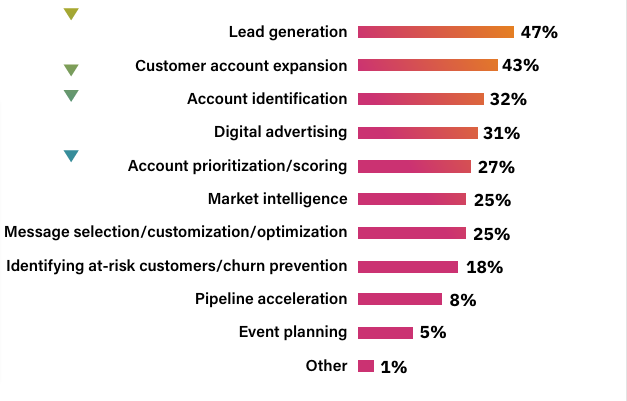
Source: Ascend 2 Research Report The State of Intent Data for GTM Teams
For example, you’ll be able to deliver content that is most relevant to each account's current research behaviors. This means that instead of broadly targeting all potential leads, you can zero in on those who have shown specific intent signals—such as visiting certain web pages, downloading relevant content, or interacting with specific ads.
This kind of intent-based targeting results in higher conversion rates. No wonder, according to our own State of Intent Data report, 59.6% of people are using intent data and are planning to expand on using them.
Sources and types of intent data
There are two types of intent data. And each can be collected from various sources. The two types of intent data include:
-
First-party intent data
This data is collected directly from your digital assets, such as your website, CRM, or marketing automation system. It includes information on how visitors interact with your content and which products or services they show interest in.
N.Rich does this automatically. It collects this data through its tagging system. It allows you to understand how engaged an account is with your brand. Its B2B Demand-Side-Platform (DSP) then combines these insights and delivers personalized content across 5,000+ websites to the right decision-makers across the buying committee. Unlike other platforms that rely on impressions, N.Rich’s ABM platform focuses on real engagement metrics—like clicks, video views, and website visits.
-
Third-party intent data
Third-party data is collected from external sources. It includes information on how users interact with content, websites, or advertisements outside your brand’s ecosystem. Third-party intent data can help you identify potential customers who are showing interest in your industry or products.
Sources of this data include industry-related publications and intent data platforms like N.Rich. We integrate with our proprietary intent data network and analyze millions of interactions across the web.
How intent-based marketing works
Intent-based marketing works by analyzing various data points that indicate a potential customer’s intent to purchase. This can include actions such as visiting specific websites, downloading whitepapers, attending webinars, or even searching for particular keywords online. B2B data enrichment can augment this analysis by supplying supplementary information, enabling a more comprehensive understanding of customer intent. You can then use this data to identify and target prospects who are in different stages of the buying journey.
For example, a prospect who has been researching project management tools might receive targeted ads, emails, or content related to project management best practices or product comparisons.
However, most products have no direct relationship with the third-party data collected. So it’s difficult to provide you with actionable steps to take at the account level.
N.Rich improves this process by providing comprehensive buyer journey insights. It’s the only platform that uses AI to analyze both first-party and third-party intent data at the account level.
It can then predict the stage of the buyer journey—whether a prospect is Cold, In-market, Engaged, or Hot—and suggest personalized marketing actions for each stage. For example, it can identify when to launch targeted ad campaigns, share relevant content, or make direct sales outreach.
Why is intent-based marketing important?
From what we’ve looked at so far, we can say personalization, powered by predictive intent, is the biggest benefit you can get from adopting intent-driven marketing. And according to Inbox Insight, 62% of B2B marketers would agree since they have been able to improve personalization and nurture workflows due to intent data.
Here are other benefits of implementing intent-based marketing based on a study we conducted where we interviewed 56 people from consultants to C-level:
-
Improves lead and account prioritization
This approach ensures that resources are focused on prospects most likely to convert. It does this by using intent data such as site visits. These high-intent signals reveal which prospects are closer to making a purchasing decision. So this allows you to prioritize them over others who may only have a casual interest.
That’s why according to our State of Intent Data Study, 69% of respondents use intent data for this purpose, making it the most common use case.
As Sam Tabak, Co-Founder, Rabbi Meir Baal Haness Charities also noted:

-
Improves marketing campaign performance
Intent-based marketing tracks specific actions taken by prospects. Once this behavioral data is collected, it is analyzed to determine the level of interest and intent behind the actions. With that understanding, you can create targeted campaigns to coincide with the prospect's decision-making process. This will result in improved marketing efforts.
The report highlights that 40% of respondents use intent data to enhance their marketing efforts. As Grant Polachek, Marketing and Operations, Squadhelp, explains:
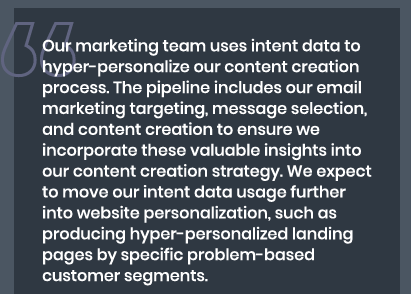
-
Boost outreach efficiency
Intent data helps sales teams to prioritize leads based on their level of intent. So prospects who display stronger intent signals, such as repeated visits to a product page are likely further along in their buying journey. The sales team can therefore focus their outreach on these prospects who are already showing signs of buying intent.
The study indicates that 48% of respondents use intent data to optimize their outreach efforts. As Sara Bonilla Reyes, Global Head of Growth Marketing, Plentific, described:
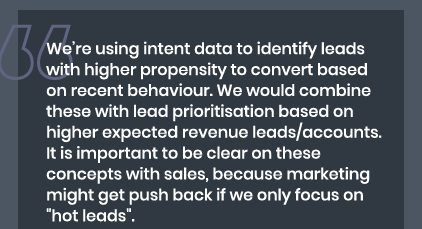
-
Supports sales and marketing alignment
Intent data serves as a common source of truth for both sales and marketing teams. They both analyze the same data so they can understand where each prospect is in the buying journey.
But for the sales team to fully use this data, it has to be where they spend most of their time, in the CRM. That’s why N.Rich integrates directly with major CRMs. It pushes the most valuable intent data, including the Intent Score, directly into the account profile. This means both sales and marketing teams have easy access to the same actionable insights.
How to implement an intent-based marketing strategy
While it sounds exciting to implement, 42% of GTM teams face the challenge of creating a strategy from the intent data.
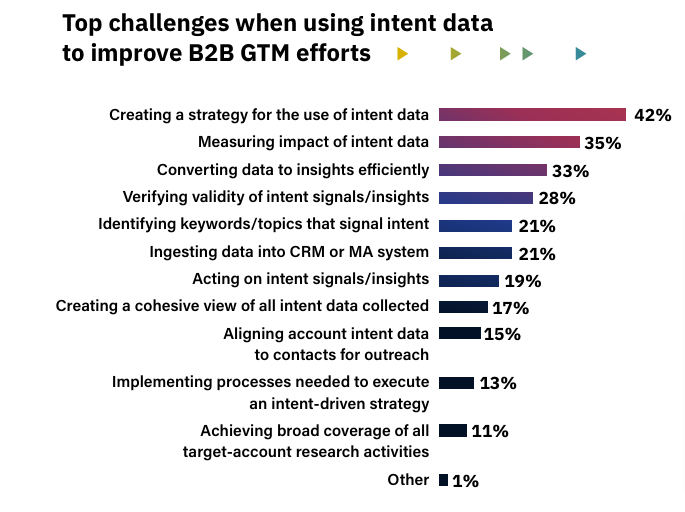
Source: Ascend 2 Research Report The State of Intent Data for GTM Teams
In this section, we’ll try to help with that. We’ll describe a few steps that you can take to realize the benefits of an intent-based marketing strategy.
-
Define your goals
As is with any strategy, you have to know what you want to achieve. Are you looking to improve lead generation, enhance account prioritization, or boost conversion rates? Knowing this will help you identify what success looks like.
For example, when your goal is to boost account prioritization, you’ll use first-party and third-party intent data to track online behavior. From this data, you’ll be able to focus on accounts most likely to convert.
-
Identify your ICP
Identifying your ICP will help you focus your marketing efforts on the right audience. But most ICPs are set in stone. You might be using the same ICPs from one year ago. The problem with this is that the market changes.
N.Rich automatically creates ICPs for you. Its algorithm examines your CRM data, specifically looking at both won and lost opportunities. It assesses key factors such as the monetary value of won deals, win rates, and the length of the sales cycle.
The algorithm then pinpoints accounts that exhibit the highest sales velocity, meaning they close faster and with better outcomes. It then identifies common characteristics of these high-velocity accounts.
Based on the identified characteristics, N.Rich automatically builds a Target Account List (TAL) of in-market accounts that match your ICP. But it doesn’t end there. The algorithm runs automatically on a regular basis, updating the ICP scoring as new data is added to your CRM.
-
Create targeted campaigns
Now you can create targeted content according to the stages of the buyer’s journey. With N.Rich, you can develop personalized LinkedIn ad campaigns by targeting specific behaviors, such as visits to high-intent pages like pricing or demo pages.
For example, if a company has visited a competitor comparison page on your website, you can create an ad that directly addresses why your solution is superior and invite them to schedule a call. You can also combine first-party data with third-party intent signals to create targeted campaigns.

-
Prioritize high-intent leads
You can also put more focus on leads that show strong buying signals. But with the current tools, it’s difficult to act on intent signals or verify the validity of these signals.
N.Rich addresses this challenge by creating a comprehensive Intent Score that accurately reflects an account’s overall engagement with your brand and industry. The Intent Score is calculated by applying weighted values to the first-party and third-party data. This results in a composite score that categorizes accounts into Low, Medium, or High intent.
For example, a score of 70 or above indicates a high level of interest and makes the account a prime target for immediate outreach.
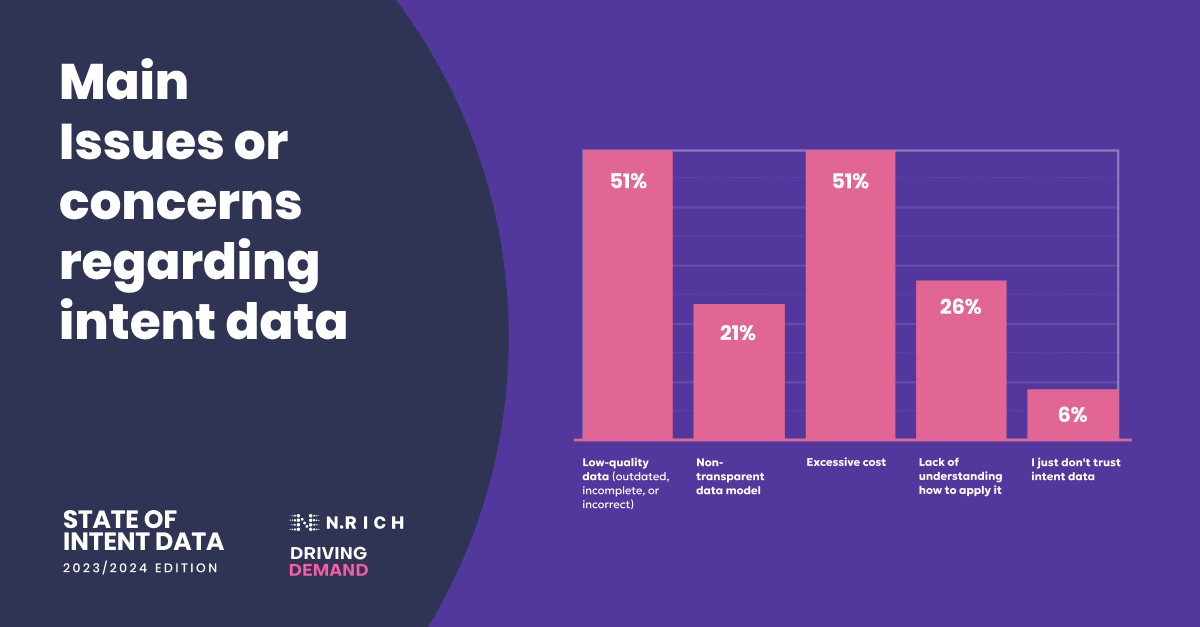
Limitations of intent-based marketing
However, before implementing your strategy, it’s crucial to be aware of potential setbacks. Here are some limitations based on our report:
-
Low-quality data
One of the most significant concerns is the quality of intent data. Marketers often struggle with data that is outdated, incomplete, or incorrect, leading to misguided marketing efforts. N.Rich tackles this issue by using its proprietary intent data network. It ensures high data quality by integrating first-party data with third-party data collected from a vast network of B2B websites and media companies. Its algorithm then establishes accurate user interest in contextual topics and links anonymous user data to company identifiers, providing reliable intent data at the account level.
-
Non-transparent data models
There are concerns over how intent data is collected and analyzed. Respondents expect data providers to explain their data sources and algorithms. At N.Rich we provide full transparency by allowing you to customize the weighting of first-party and third-party data sources when configuring the Intent Score. This customization gives you the flexibility to prioritize certain data sources depending on their specific needs, whether it’s for account discovery or deeper engagement tracking.
-
Lack of understanding on how to apply it
Even when intent data is available, some marketers find it challenging to understand how to use it effectively. They expect data providers to publish tutorials. N.Rich addresses this challenge by offering a comprehensive knowledge base filled with detailed guides. You have access to step-by-step instructions on creating and interpreting intent reports, running account-based advertising campaigns, and using workflows to manage segments.
-
Cost
The high cost associated with investing in a new tech stack is another major concern for businesses. More so when the data provided by these platforms is deemed low quality.
Conclusion
Intent-based marketing will change the way you connect with customers. You’ll now personalize your marketing campaigns by using intent data to identify and target prospects based on their online behavior and buying signals. You’ll streamline lead prioritization by using intent data to improve your lead-scoring efforts.
It will also boost your outreach campaigns as the sales team will focus more on high-intent leads. Moreover, there’ll be better alignment between your sales and marketing teams as they both analyze the same data.
And to implement an intent-based marketing strategy, you can start by defining your goals and identifying your ICPs. Dive deep into your existing customer data and analyze past deals. But this can be a tedious process that’s why N.Rich automatically creates ICPs for you.
Then segment your audience based on their intent signals and buying stage. Use this segmentation to create targeted campaigns that speak directly to each group's specific pain points and concerns at each stage of their buying journey.
You can book a demo to learn more about how N.Rich will help you implement an intent-based marketing strategy.

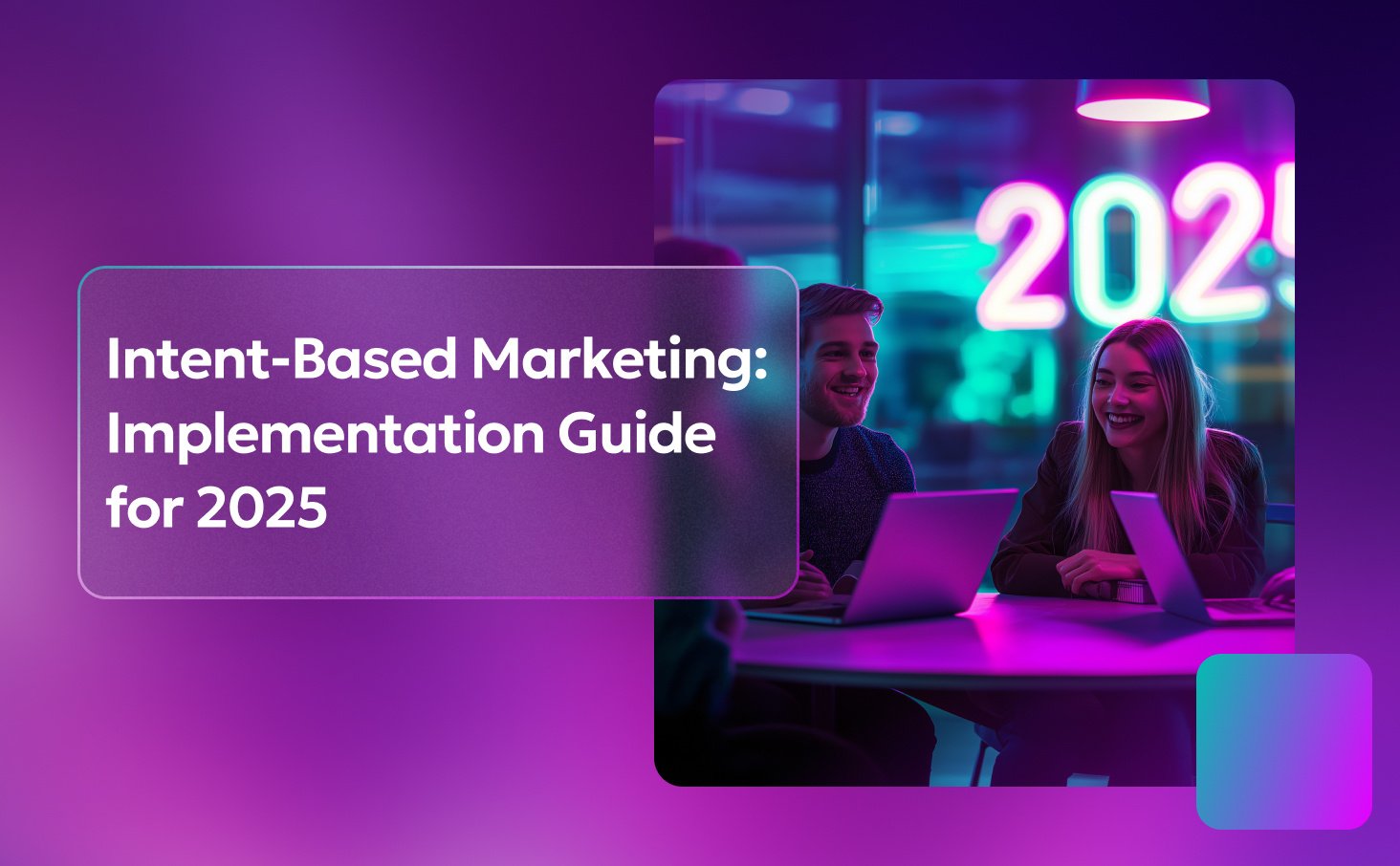
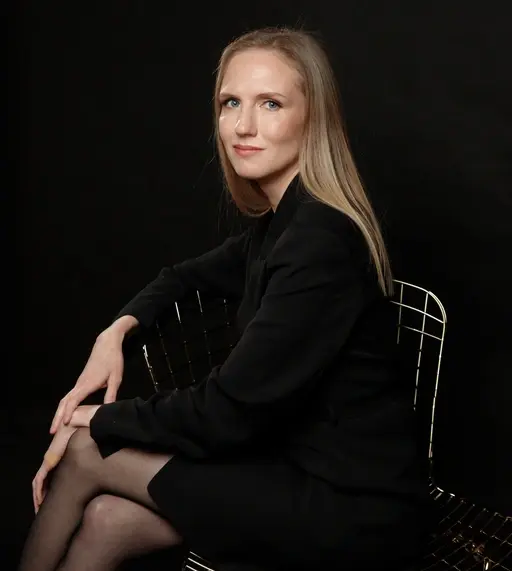








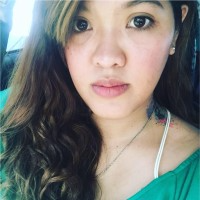
.webp)